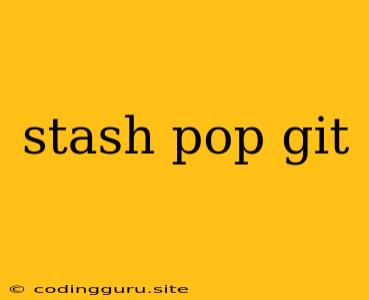Understanding Git Stash: A Powerful Tool for Clean Workflows
Git stash is a valuable tool for developers using Git version control. It allows you to temporarily save your changes, making your working directory clean. This is particularly useful when you need to switch branches or pull in updates from the remote repository, but aren't ready to commit your changes.
When Should You Use Git Stash?
There are many scenarios where using git stash can be beneficial:
- Switching Branches: You're working on a feature branch but need to quickly switch to another branch to fix a bug or make a small change.
- Pulling Updates: You need to pull in the latest changes from the remote repository but don't want to commit your unfinished work.
- Resolving Conflicts: You have uncommitted changes that are causing conflicts with the latest changes from the remote repository. Stashing your changes temporarily can help you resolve these conflicts more effectively.
- Experimenting with Changes: You want to try out some new code but don't want to commit it yet. Stashing allows you to save these experimental changes without committing them.
The Basics of Git Stash
1. Stashing Your Changes:
The core command for stashing changes is:
git stash
This command saves your uncommitted changes to a temporary "stash". Your working directory will now be clean, reflecting the state of the HEAD commit.
2. Viewing Your Stashes:
To see a list of your stashed changes, use the following command:
git stash list
This will display the different stashes you have created, including their names and associated messages.
3. Applying Your Stashed Changes:
To apply your stashed changes, use the following command:
git stash apply
This will bring back the changes from the most recently stashed state. However, it leaves the stash in place.
4. Deleting Your Stash:
Once you are done with your stashed changes, you can delete them using:
git stash drop
This will permanently remove the stash from your repository.
Working with Multiple Stashes
You can create multiple stashes using different names. For instance, you can name your stashes using descriptive names that reflect the nature of the changes.
git stash push -u "Fixing the login bug"
git stash push -u "Implementing new feature"
To apply a specific stash, you can use the following command:
git stash apply stash@{1}
This will apply the stash named "Fixing the login bug".
The 'Pop' Option
git stash pop combines both applying the stash and deleting it. It is often the preferred method to retrieve and remove a stash in a single step:
git stash pop
Important Considerations
- Stashes are temporary: Stashed changes are not permanently stored in your Git history. You need to apply them or delete them eventually.
- Stashes can be overwritten: If you create a new stash, it will overwrite the previous stash. Make sure to use descriptive names or use the
git stash pushcommand to avoid overwriting your stashes.
Example: Switching Branches and Applying a Stash
Let's say you are working on a branch named "feature-branch". You have some uncommitted changes and need to switch to the "master" branch to fix a bug. You can use git stash to save your changes temporarily and then apply them later.
git stash
git checkout master
# Fix the bug
git commit -m "Fixed bug in master branch"
git checkout feature-branch
git stash apply
git add .
git commit -m "Completed feature"
Conclusion
Git stash is a valuable tool that can help you keep your working directory clean and efficient. Understanding how to use git stash effectively can significantly improve your Git workflow, making it easier to manage your code and switch between branches. Remember to utilize the stash list command to track your stashes and use stash pop for convenience.
